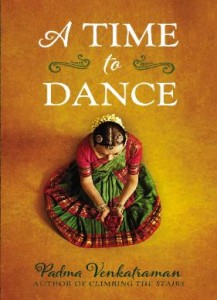 A Time to Dance, Padma Venkatraman
A Time to Dance, Padma VenkatramanNancy Paulsen Books (Penguin), May 2014
Reviewed from ARC
Joy referenced the #weneeddiversebooks movement a few posts back, when she talked about two black ballerinas, one fictional and one actual. In some ways, A Time to Dance could have been included in that post: it’s a book about a dancer who is also a person of color. But in other, critical ways, this entirely different, and not only because it’s a novel in verse and getting way more critical acclaim.
This isn’t perfect, but it definitely beats out those other dance books we’ve seen this year and the other novel in verse I’ve read so far (with the caveats that Brown Girl Dreaming is next to read, and I don’t consider How I Discovered Poetry a novel).
Topically, this is unlike anything else out there (and not just in 2014). It’s about religion and faith, injury and healing, grief and loss and most of all about moving beyond surface layers to the true heart of things. The frank discussion of religion, which is so important to Veda and also so much more interwoven with life in Veda’s world (by which I mean both her personal world and also India, where the novel is set), is astounding; the idea that spirituality matters, that it shapes people, and that it’s a deep experience that requires work — wow. We so rarely get books that have that discussion intertextually, and the fact that it is absolutely accessible to a not-Indian, not-Hindi, not-dancing reader despite being so grounded in those specific elements speaks to the skill with which Venkatraman has evoked the rich interior and exterior world of the main character in relatively little text.
Speaking of that main character — Veda is a likeable protagonist, an adolescent figuring out some very big questions (see previous paragraph) while also negotiating friendships and even the beginnings of a romance. She’s immensely skilled at bharatanatyam dance — almost a prodigy — and at the start she has a bit of an attitude, because she’s excellent at the thing she does and she knows it. She is also a little too self -aware — even before the accident that costs her a leg, she recognizes that she has lost some of the pure joy in dance she experienced as a child. And because bharatanatyam is a religious form of dance, that means that she’s failing to do what a bharatanatyam dancer should do, an awareness which sets up the movement of the entire novel. That overly self-aware narrative voice occasionally makes her too good — yes, she wasn’t all that friendly to others because she was so focused and successful, yes, she was a little smug, so she’s not perfect — but she sees all of this and never flinches from confronting her own imperfections. She might be a little annoying, really, if she weren’t dealing with something so terrible. Of course, that self awareness is also the quality that allows the reader to experience her growth after the accident, from anger to acceptance and back to dance (thanks to a prosthetic leg and an insane amount of determination), a journey that is genuinely emotional.
The verse here is… fine. It reminded me of Ellen Hopkins’ verse; the form itself isn’t necessarily astounding, but the space between the words has a presence. In this case, in a story concerned with the search search for divinity and connection to god, a form that leaves spaces between words and thoughts, that forces the reader to search is perfect, so although the poetry itself wasn’t knock-your-socks-off, the way it allowed the tale to form was excellent.
This is a beautifully moving story, is what I’m saying. That slight tendency towards the unsubtle is the biggest flaw, and while it’s not a deal breaker, on the second go through I found Veda a little too perfect to be fully dimensional. Given that her character and emotional and physical journey are the heart of this one, that flaw brings this one down a bit. I’ll be surprised if it goes the distance, but I’d also be shocked if it didn’t garner some conversation before falling off the table, not that we’ll ever know.
![]()
ALREADY A SUBSCRIBER? LOG IN
We are currently offering this content for free. Sign up now to activate your personal profile, where you can save articles for future viewing



Be the first reader to comment.
Comment Policy:
Comment should not be empty !!!